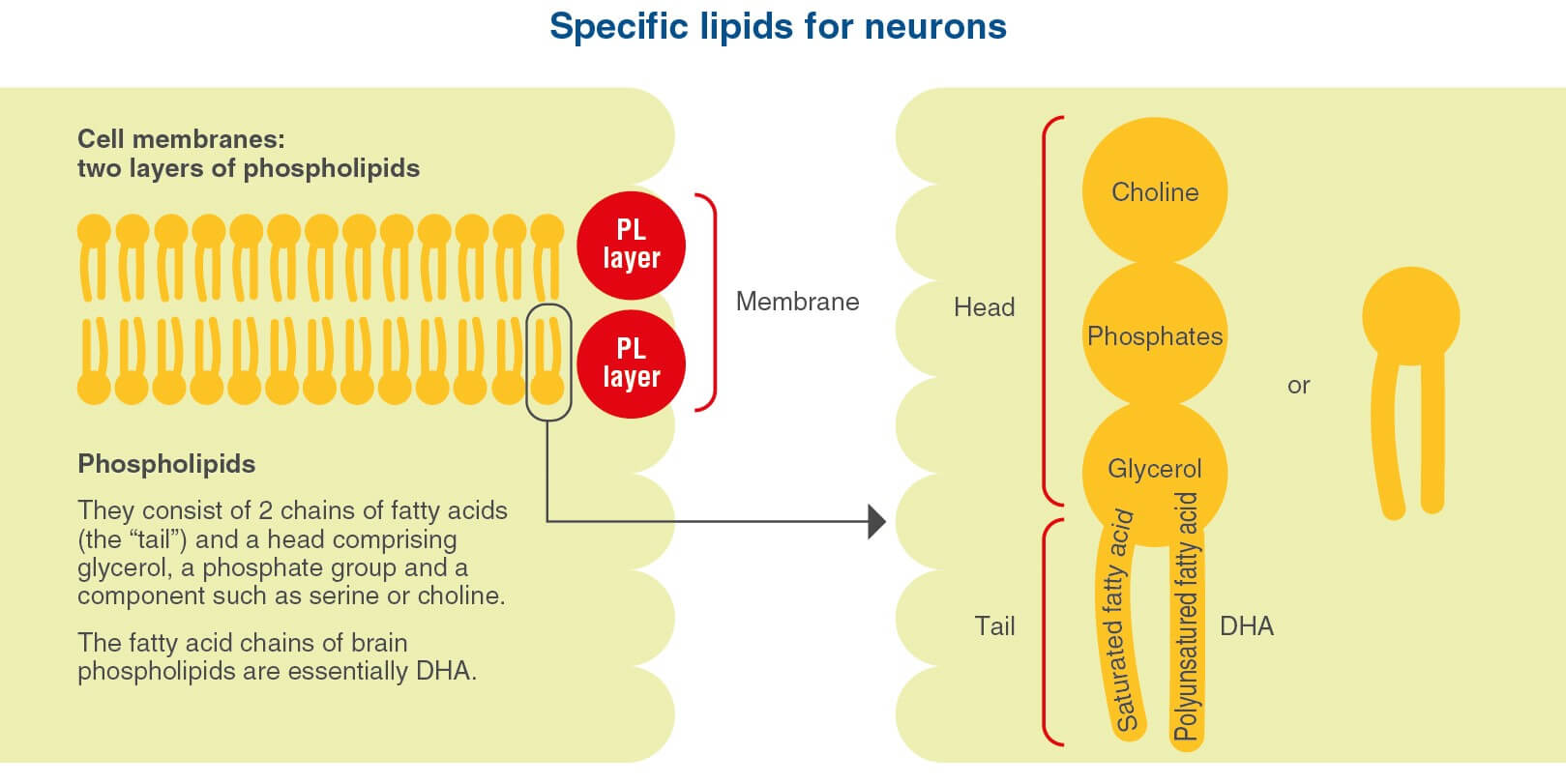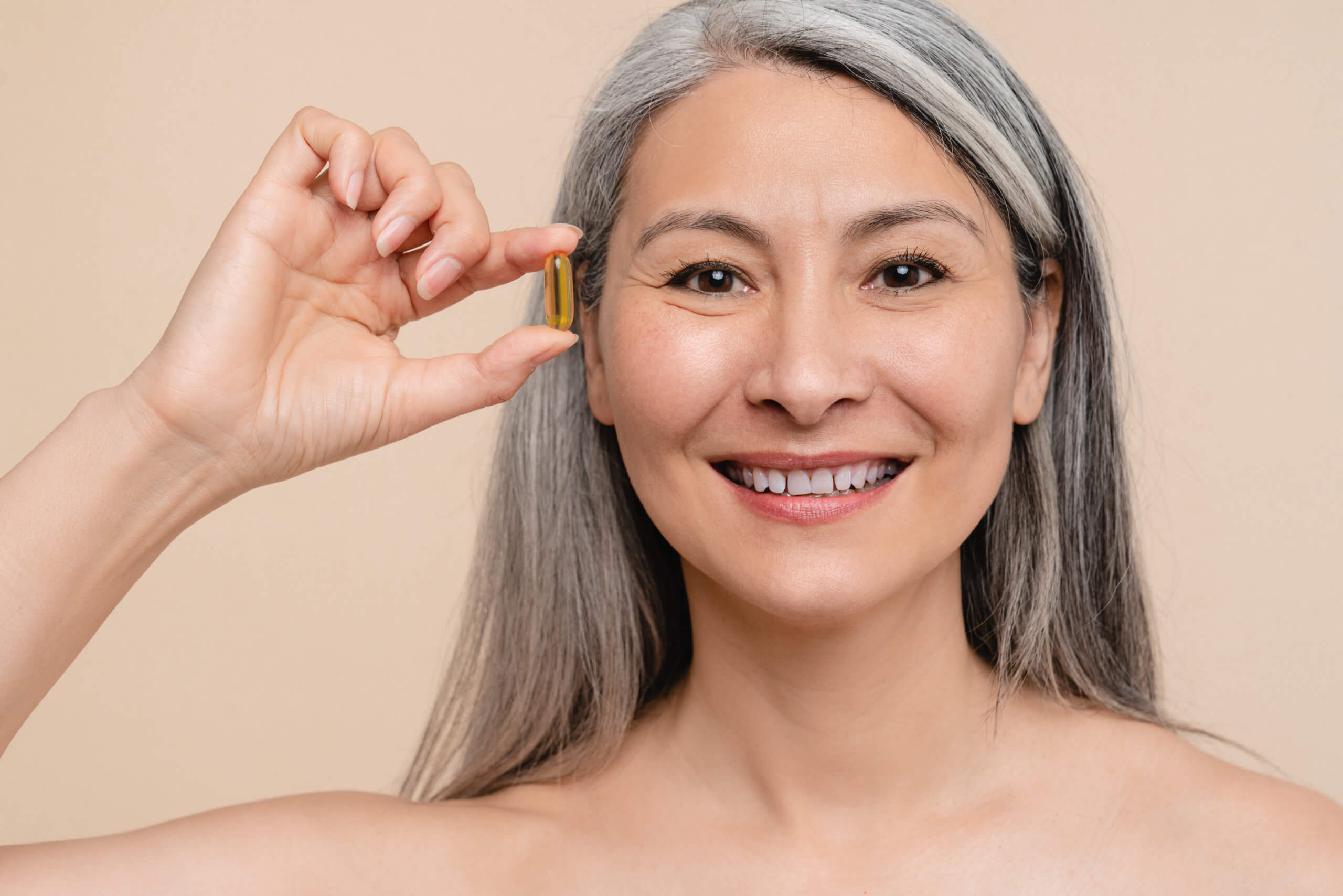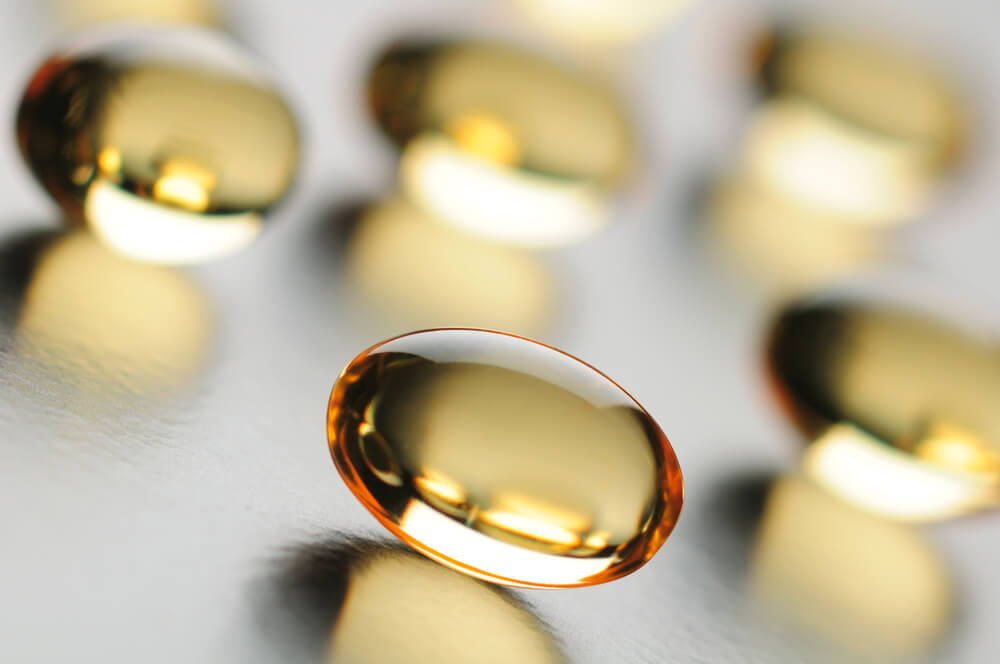OMEGA-3: TO MAINTAIN ENERGY AND VITALITY!
Our body undergoes physiological changes over the years, particularly for the brain, eyes, cardiovascular system and skin.
Find out in this article how omega-3 helps to maintain and operate these organs.
OMEGA-3 & COGNITION
Aging and cognitive decline
Like other organs, the brain undergoes cell aging, causing a decrease in cognitive performance. After a performance peak at 18-25 years, its functional capacities gradually decline [1,2]. It is estimated that cognitive decline occurs at around 45 years of age [1].
Cognitive changes associated with physiological aging involve:
- a less efficient memory
- less effective attention
- possible language disorders
- more fragile executive functions [2]
In addition, age represents a risk factor for the development of neurodegenerative diseases such as Alzheimer’s. Indeed, its prevalence increases with age where it affects more than 20% of people over 80 compared to 3% for those over 65 [3].
Omega-3 to slow down brain aging
The brain is the 2nd most lipid-rich tissue (50%)[4] whose neuron membranes are characterized by the presence of specific fatty acids such as omega. Docosahexaenoic acid (DHA) is the most abundant omega-3 fatty acid in the brain[5].
Unlike adipose tissue, these fatty acids play a structural and functional role in ensuring the fluidity and integrity of neurons. DHA is one of the major components of cell membranes that facilitate the release of certain neurotransmitters and contribute to membrane renewal [6].
Phospholipid structure[7]
The importance of brain lipids and omega-3 in particular has been demonstrated in several studies. This research shows the association between a low blood level of omega-3 and the incidence of neurological diseases with an inflammatory component [8]. An alteration in the lipid distribution of brain cells is therefore associated with the development of neurological diseases [9].
To cover the needs for omega-3 contributing to normal brain function, it is recommended to consume at least 250 mg/g of DHA/EPA per day, via diet or via supplements. This intake makes it possible to maintain the ideal lipid composition [10,11].
CARDIOVASCULAR SYSTEM AND OMEGA-3
Cardiovascular disease
Did you know that cardiovascular disease is the leading cause of death worldwide? Indeed, with more than 17.7 million deaths per year, it represents a real global public health challenge. [12]
Although the etiology of these diseases is multifactor, there are several risk factors that can lead to or promote this disease. This is particularly the case for age, which has been associated with a marked increase in the probability of developing a cardiovascular event after 50 years in men and 60 years in women [13].
In addition, high levels of triglycerides and LDL-cholesterol are also correlated with an increased risk of developing one of these conditions. However, there is a significant prevalence of dyslipidemia in age groups aged 55 to 74 (67% in men) [14,15].
Nevertheless, a good diet, particularly composed of foods rich in omega-3 represents a protective factor for these pathologies [16,17].
Omega-3 for a healthy cardiovascular system
Omega-3, especially long chain Omega-3, is recognized for its cardiovascular health benefits.
A recent meta-analysis conducted in 2020 published in the Mayo Clinic Proceedings highlights the role of DHA and EPA in reducing the risk of myocardial infarction, heart attack and mortality related to cardiovascular disease [18]. Based on these randomized controlled trials, this study notes the significant reduction of certain risk factors such as dyslipidemia, thanks to the consumption of EPA and DHA in high-risk populations [18].
|
Do you know the health claims for omega-3? · “DHA helps maintain a normal concentration of triglycerides in the blood” · “EPA and DHA help maintain normal blood pressure” · “EPA and DHA help maintain a normal concentration of triglycerides in the blood.” · “EPA and DHA contribute to normal cardiac function” |
EYESIGHT AND OMEGA-3
Aging eyesight
Sight is one of our 5 senses. With age, like any other organ, the eye is subject to aging and the possibility of developing eye disease.
The leading cause of visual impairment in the elderly is macular degeneration, which mainly develops from the age of 50. Indeed, with age, there is a deterioration of the macula, an area of the key retina in the processes of vision [19,20].
The second leading cause of blindness in France is glaucoma, which affects 1 to 2% of the population aged over 40 and approximately 10% after the age of 70. Its frequency increases with age. It is a chronic disease of the eye associated with the progressive destruction of optic nerve fibers. These injuries result in a decreased visual field and thus lead to impaired vision. It is favored by excessive intraocular pressure [21].
Finally, 15% of people over the age of 60 suffer from dry eye disease. It involves poor quality and/or reduced quantity of tears, often seen in older people. As they age, the tear glands atrophy, leading to reduced tear production. This symptom can then lead to irritation of the cornea, as well as infections of the eye [22].
Decreased vision due to age is not inevitable. A balanced diet helps maintain eye health. Indeed, certain nutrients are known to play a protective role against vision deterioration. This is particularly the case for carotenoids, lutein and omega-3 recognized for their health benefits on the eyes [23].
Omega-3 and eye health
The retina is a structure of the eye that has the highest concentration of DHA in the body. In addition to its structural role, this fatty acid is a key factor in how these eye cells that are involved in vision function. The claim that “docosahexaenoic acid contributes to maintaining normal vision” can be obtained provided that the foodstuff contains at least 40 mg of DHA per 100 g and per 100 kcal. In addition, this beneficial effect can be communicated to consumers when they consume 250 mg of DHA during the day[23]. In addition, long-chain omega-3 is recognized for its long-term benefits in preventing a range of eye problems [24].
Several studies suggest the potential benefits of these precious lipids in the management of dry eye syndrome. In particular, they help combat the deterioration of the tear film while modulating surface ocular inflammation commonly observed during this disease [24].
In addition, these fatty acids are also useful in the management of age-related macular degeneration [24]. Indeed, high DHA consumption is associated with a reduced risk of developing this disease [25].
Finally, the consumption of omega-3 fatty acids is presented as a protective factor against glaucoma by several observational studies [26,27].
These observations may come from the antioxidant properties of omega-3, which are useful in the fight against oxidative stress, as well as the damage associated with inflammation present in these neurodegenerative ocular pathologies [25].
SKIN AND OMEGA-3
Skin aging
Skin aging processes are implemented from early adulthood [28].
It is a natural evolution that is determined by intrinsic and extrinsic factors. Intrinsic factors are inevitable. Linked to age, they are genetically programmed. However, various environmental factors can accelerate or delay this skin aging process, such as significant exposure to UV rays from the sun or an unbalanced diet low in antioxidants [29].
With age, skin function is altered: skin is less hydrated, less supple and more fragile. In fact, skin cell regeneration slows down, and the activity of the sebaceous and sweat glands decreases. Collagen production also falls. As a result, there are changes in skin beauty (brands, wrinkles, more dull skin) but also an increase in the prevalence of skin cancer [30,31,32].
Omega-3 & skincare
Diet is one of the pillars for preventing skin aging.
Mainly due to its antioxidant and anti-inflammatory effects, omega-3 is used to combat oxidative stress and UV radiation that generate harmful free radicals for skin cells. In addition, they provide valuable help in preventing skin cancer [33].
In addition, a study highlights the role of EPA in the increased expression of collagen and elastin fibers, two proteins that decrease during skin aging [33].
Due to these properties, omega-3 is considered as a nutrient capable of preventing signs of aging in skin [34].
FERMENTALG, THE VEGAN OMEGA-3 SPECIALIST
Fermentalg, an expert in microalga biotechnology, offers sustainable solutions for food and nutraceutical markets. Derived from Schizochytrium sp. microalga, the DHA ORIGINS® range offers products naturally concentrated in vegan omega-3 (oils, powder and soft capsules).
The advantages of this range?
- Vegan certified omega-3 from Schizochytrium sp. microalga can be suitable for the entire population.
- Sustainable omega-3 by harvesting the “super-producer” strain once and only once in its natural environment.
- Omega-3 in the form of triglycerides (TG) obtained by a solvent-free extraction process. This lipid structure is one of the native forms of fatty acids.
- Omega-3 naturally concentrated with high DHA content without any chemical process or enrichment, with a minimum of 550 mg/g DHA (as FA)
- Omega-3 with a “neutral” taste with a mild organoleptic impression, ideal for taking this omega-3.
SOURCES
[1] Archana Singh-Manoux et al., 2012, Timing of onset of cognitive decline : results from Whitehall II prospective cohort study, BMJ
[2] Bernadette Ska et Yves Joanette, 2006, Vieillissement normal et cognition, Med Sci.
[3] Association France Alzheimer, Article “Premiers repères sur la maladie d’Alzheimer”
[4] https://alwaysomega3s.com/why/brain-health
[5] https://www.fatsoflife.com/health-benefits/brain-health-benefits
[6] Communiqué – Salle de presse INSERM, 2014, Des lipides au service du cerveau
[7] https://www.pensersante.fr/acides-gras-et-cerveau-penser-sante
[8] Sala-Villa et al., 2022, Red Blood Cell DHA Is Inversely Associated with Risk of Incident Alzheimer’s Disease and All-Cause Dementia: Framingham Offspring Study, Nutrients
[9] Yu-Chia Kao et al., 2020, Lipids and Alzheimer’s Disease, Int J Mol Sci.
[10] Nutrition Santé, 2006, Article, Vieillesse et modification du métabolisme des AGPI oméga 6 et oméga 3
[11] Valls-Pedret C, Sala-Vila A, Serra-Mir M, et al., 2015, Mediterranean Diet and Age-Related Cognitive Decline: A Randomized Clinical Trial. JAMA Intern Med
[12] Christian Galasso et al., 2018, On the neuroprotective role of astaxanthin : new perspectives?, Mar Drugs
[13] OMS, 2017, Maladies cardiovasculaires
[14] L’assurance maladie Ameli, 2022, Le risque cardiovasculaire et ses facteurs
[15] J.Ferriers, Service de cardiologie, CHU Rangueil, Toulouse, Revues générales “Le risque cardiovasculaire: Prévalence des différentes dyslipidémies en France”
[16] Fédération Française de Cardiologie, 2021, Ce qu’il faut savoir sur les oméga-3
[17] Blog Nestlé NutriPro, Article “Nutrition et pathologies cardiovasculaires”, 2012
[18] Aldo A. Bernasconi et al., 2020, Effect of omega-3 dosage on cardiovascular outcomes : an updated meta-analysis and meta-regression of interventional trials
[19] L’assurance maladie Ameli, 2021, Comprendre la dégénérescence maculaire liée à l’âge (DMLA)
[20] Inserm, 2017, Dégénérescence maculaire liée à l’âge (DMLA), une perte progressive de la vision centrale
[21] L’assurance maladie Ameli, 2022, Comprendre le glaucome
[22] L’assurance maladie Ameli, 2021, Sécheresse oculaire : définition, symptômes et causes
[23] AlwaysOmega3s, Infographie “Nutrition for eye health”
[24] Alexis Ceecee Zhang et al., 2020, Omega-3 fatty acids and eye health : opinions and self-reported practice behaviors of optometrists in Australia and New Zealand, Nutrients
[25] Elisabeth M.van Leeuwen et al., 2018, A new perspective on lipid research in age-related macular degeneration, ScienceDirect
[26] Jean-Paul Renard and al., 2013, Nutritional, lifestyle and environmental factors in ocular hypertension and primary open-angle glaucoma : an exploratory case-control study, Acta Ophtalmol.
[27] Jae H Kang and al., 2004, Dietary fat consumption adn primary open-angle glaucoma, Am J Clin Nutr.
[28] PharmaFutur, 2018, Les facteurs responsables du vieillissement prématuré de la peau.
[29] Jeannie Khavkin et David A.F. Ellis, 2011, Aging skin : histology, physiology, and pathology, Facial Plast Surg Clin North Am
[30] Centre de lutte contre le cancer Léon Bérard, Cancer de la peau – Mélanome
[31] Varani J et al., 2006, Decreased Collagen Production in Chronologically Aged Skin: Roles of Age-Dependent Alteration in Fibroblast Function and Defective Mechanical Stimulation. Am J Pathol
[32] Yu Sawada et al., 2020, Omega3 fatty acid and skin diseases, Frontiers in Immunology
[33] Hyeon Ho Kim et al., 2006, Photoprotective and anti-skin-aging effects of eicosapentaenoic acid in human skin in vivo, J Lipid Res
[34] Soyun Cho, 2014, The role of functional foods in cutaneous anti-aging, J Lifestyle Med
[35] Institut National du Cancer, 2022, Le mélanome de la peau







